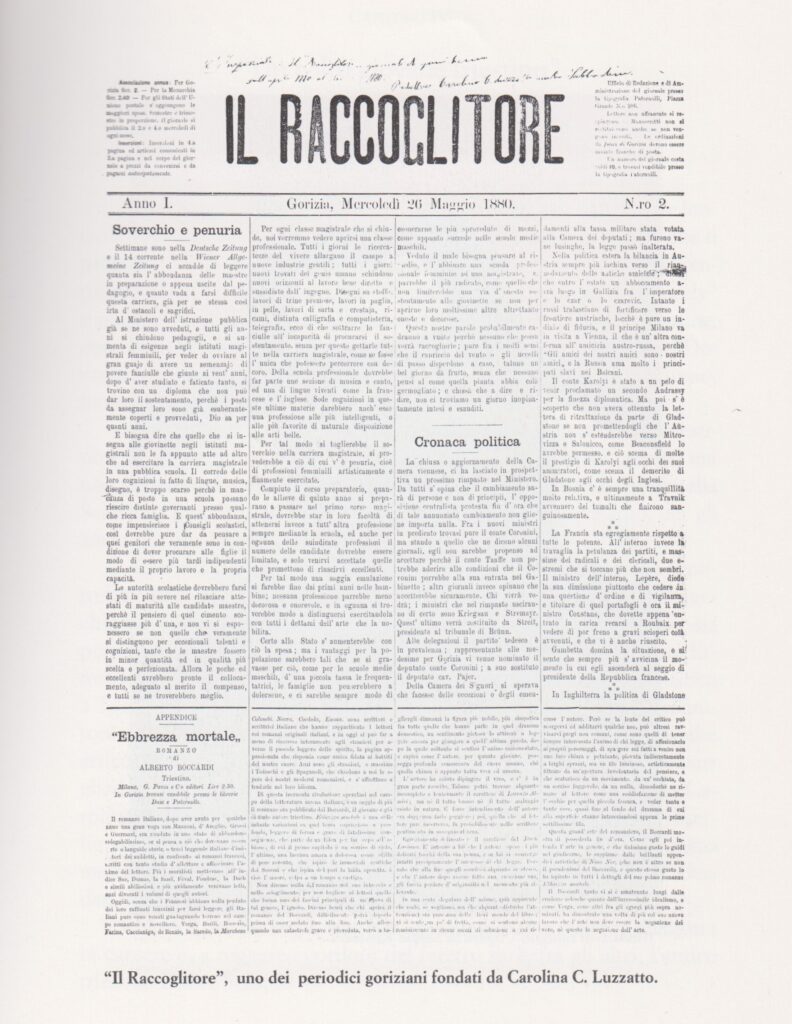Learn More

Carolina Sabbadini Coen Luzzatto was born in Trieste on 26 November 1837. She was the daughter of Isach Sabbadini and Stellina Norsa, and grew up in a lower middle class Sephardic Jewish family, who were strongly tied to religious traditions. Her maternal grandfather, Isaia, taught her French and encouraged her to dedicate herself to literature and writing poetry. Another important figure during her childhood was the Rabbi Marco Tedeschi, an Orientalist and Italian patriot who contributed to the drafting of the Albertine Statute of 1848.
In 1856 she married the trader Girolamo Coen Luzzatto and moved to Gorizia. Here she worked with newspapers and local magazines, including Patria del Friuli, Pagine friulane, Il Piccolo, La Giovane Trieste, Il Progresso, Il Corriere friulano, la Penna. She managed L’Isonzo, L’Imparziale, Il Raccoglitore and the Corriere di Gorizia, and was the first woman in the Italian Peninsula to do so. She dedicated herself to social topics, such as compulsory education, training and female emancipation. She also covered political topics, with irredentist articles with strong anti-Austrian, anti-clerical and, over the years, also anti-Slavic and racist tones. The Slovenian press in Gorizia responded with anti-Jewish stereotypes, sexist statements and more personal attacks (including blaming her for her daughter’s suicide, which occurred in 1895).
Carolina was also a French and German translator, and educated members of the Gorizian Jewish middle class, for whom she wrote various texts on religious formation and in favour of Italy. In 1868 Carolina was involved in the creation of the philanthropic association “Società delle Signore a Sollievo dei poveri” (Society of Ladies for the Relief of the Poor).
In multilinguistic Gorizia, Carolina came into contact with middle-class Italophile intellectuals, becoming a reference point for many (including her nephew Alberto Michelstaedter), whom she met in the Casino dei Commercianti e Industriali, which was located in Contrada Seminario 119, in the same building where she lived with her husband.
In 1880 she moved to Via Arcivescovado, where she lived until 1915, when she was arrested by the Austrian authorities at the age of 79 as an open supporter of the Kingdom of Italy. Carolina was taken to a camp for intellectual and political prisoners in Göllersdorf. Due to her failing health, after nearly a year she was sent to the border at Oberhollabrunn, where her family were able to visit her
At the end of the War, Carolina did not return to Gorizia, since the city was largely destroyed (including her house and many of her writings), but instead moved to Trieste with her nephew Salvatore Sabbadini, an historian and classical philologist. General Petitti di Roreto, first Governor of Trieste, wished to meet with Carolina as soon as she reached the city on 3 November.
At the start of 1919, the journalist returned to Gorizia, where she died on 24 January. She is buried in the cemetery of Valdirose.
SOURCES:
Maura Bozzini La Stella, Carolina Coen Luzzatto, Edizioni della Laguna, Monfalcone 1995
Barbara Vallati, Carolina Coen Luzzatto (1837-1919): il percorso di una giornalista tra irredentismo ed ebraismo, undergraduate thesis in “Jewish History”, Università degli Studi di Trieste, Faculty of Literatures and Philosophy, degree in modern literature 2006-2007
Translation from Italian to English by Bethany Gaunt
Project by
Jewish Community of Trieste and Ca’ Foscari University Venezia
Info
visit@triestebraica.it
